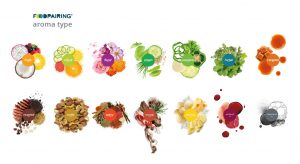Flavor is more than just the taste  of food—it’s a complex experience that involves both olfactory (smell) and gustatory (taste) sensations. My journey with flavors in foods and drinks took me down the rabbit hole of flavors. Here is a short account of this journey from the last few months.
of food—it’s a complex experience that involves both olfactory (smell) and gustatory (taste) sensations. My journey with flavors in foods and drinks took me down the rabbit hole of flavors. Here is a short account of this journey from the last few months.
The Science of Flavor Molecules
At the core of flavor is chemistry. Flavor molecules are responsible for the aromatic and taste qualities of food and beverages. They are detected by our sensory organs, triggering responses that can be sweet, sour, salty, bitter, or umami. But these molecules do more than just provide taste—they can also influence metabolic processes, impacting our health.
Flavor Molecules and Health
Recent research has highlighted the importance of flavor molecules in metabolic regulation. Some of these molecules can influence digestion, absorption, and even the body’s metabolic rate. Understanding these effects can lead to healthier food choices and improved well-being.
Cataloging Flavor Profiles
Given the importance of flavor molecules in both culinary and health contexts, it’s valuable to have a detailed repository. Such a resource would include:
- Natural Sources: Identifying where specific flavors originate, be it a spice, fruit, or herb.
- Physicochemical Properties: Understanding the stability, solubility, and reactivity of these molecules.
- Sensory Responses: Document the taste and aroma profiles they produce.
Pairing Flavors
Knowing the flavor profiles of different molecules allows for creative and harmonious pairings in cooking and perfumery. For instance, the earthy tones of mushrooms pair well with the umami-rich flavors of soy sauce, while the sharpness of citrus can enhance the sweetness of berries.
Two major resources that I reference for flavor pairings and combinations are FlavorID and FlavorDB.
FlavorID, the latest innovation from Foodpairing, is revolutionizing the way we think about taste and health. This groundbreaking app is not just about discovering new flavors; it’s a journey towards a healthier you. With FlavorID, you can easily check your health score, a unique feature that evaluates your dietary habits and suggests improvements. The app goes beyond generic recommendations by helping you discover your personal flavor profile. This tailored approach ensures that the suggestions for new flavors and healthier ingredients are not just good for you, but also align with your taste preferences. Imagine being introduced to a world of flavors and ingredients you never knew existed, each contributing to a healthier lifestyle. Whether you’re a food enthusiast or someone looking to enhance your diet, FlavorID offers a delightful and beneficial exploration of taste and well-being.
Exploring the Vast World of Flavors with FlavorDB
FlavorDB is an extensive repository that contains a staggering 25,595 flavor molecules, each encapsulating unique tastes and aromas. Within this collection, 2,254 molecules are specifically linked to 936 natural ingredients, categorized into 34 distinct groups. This rich variety offers a comprehensive look into the diverse world of flavors.
The platform is designed to be dynamic and user-friendly, making it an invaluable tool for various applications. Whether you’re a chef, food scientist, or just a flavor enthusiast, FlavorDB provides several exciting functionalities:
- Flavor and Structure Matching: Easily search for molecules that match specific flavor profiles or molecular structures. This feature is perfect for culinary experts looking to create unique taste experiences or for scientists exploring the chemistry of flavors.
- Ingredient Exploration: Dive into the molecular makeup of different ingredients. This allows users to understand the flavor nuances of various foods and how they contribute to overall taste.
- Novel Food Pairings: Discover new and unexpected food combinations. By understanding the molecular basis of flavors, FlavorDB can suggest pairings that might not be immediately obvious but can lead to delightful culinary creations.
- Molecular Essence Identification: Get to the heart of what makes each ingredient unique. This feature is especially useful for those in the food and flavor industry, aiming to replicate or enhance specific tastes.
- Chemical-Flavor Associations: Link chemical properties with flavors, providing a deeper understanding of why certain foods taste the way they do.
FlavorDB isn’t just a tool for exploration; it’s a gateway to new discoveries. Data-driven studies utilizing this resource can significantly advance our understanding of flavor mechanisms. This can lead to innovative approaches in food science, nutrition, and even gastronomy. The possibilities are as limitless as the flavors themselves, making FlavorDB a key player in the ongoing journey to decode the mysteries of taste and aroma.
In conclusion, flavor molecules are a fascinating and vital aspect of our daily lives. By understanding their sources, properties, and effects on our senses and health, we can enhance our culinary experiences and make informed choices about the foods we consume. The journey of exploring flavors is not just about taste — it’s about experiencing the rich tapestry of nature’s bounty.
This exploration into the world of flavor profiles and pairings offers a glimpse into the complex interplay between our senses, health, and the natural world. As we explore this dynamic and delicious landscape, we open ourselves up to a world where taste and health coexist in delightful harmony. Understanding and appreciating this intricate relationship can elevate our experience of food and aroma, turning each meal or scent into a journey of discovery.
Learn More on these websites and books:
JPS Nagi
November 24, 2023